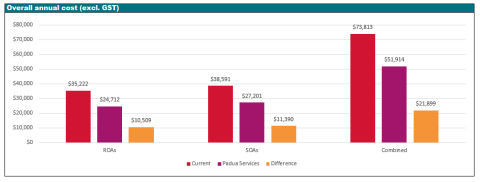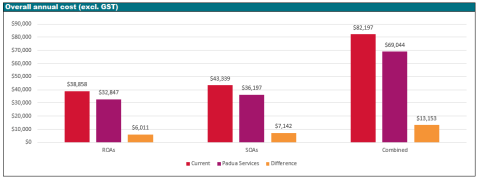The benefits of outsourcing advice generation



One of the fundamental roles of a financial adviser is to understand the needs and objectives of each client and provide strategy and product advice recommendations that align to those needs and objectives.
Unfortunately, onerous regulatory and compliance obligations often prevent advisers and their support staff from efficiently performing this pivotal role. In turn, practice profitability suffers.
For years, market surveys have been the mainstream when it comes to determining the average time it takes to produce a financial plan. And while market research often produces valuable metrics, there’s no hiding from the fact they are subjective, and outcomes may not reflect reality. Here’s a case in point.
According to each annual Investment Trends Planner Technology survey between 2010 and 2020, it takes around 6.5-7 hours to produce a Statement of Advice (SOA) on average - about two hours to perform fact finding and risk profiling, with an additional 4.5 hours or so to finalise product research, conduct detailed modelling and generate a SOA document.
Then, the Financial Services Council (FSC) and KPMG released a joint research report in 2021 that suggested the time it takes to produce a financial plan was over 20 hours – nearly three times the levels stated by the Investment Trends’ decades long surveys.
The real, data-driven reality is around 15 hours on average and surveys conducted by CoreData and IRESS support our view. In March 2022, CoreData released a report showing an average of 12.5 hours is spent producing a simple SOA and up to 30 hours to produce a complex one. IRESS (November 2021) had this as 8.1 hours for simple and 14.6 hours for complex.
The reality is, the time it takes to produce advice is considerable, and consideration must be given to getting that time back within your business.
Which type of adviser are you?
When it comes to advice generation, there are generally three types of advisers:
- DIY advisers – advisers, who for the most part, produce their own advice documents;
- Insource advisers – advisers who have internal staff, such as paraplanners or administration staff, to support them in producing their advice documents; and
- Outsource advisers – advisers who arrange for professional paraplanning firms to produce the advice documents on their behalf.
There will also be some who combine one or more of the above approaches.
Case studies
The following case studies analyse the impact and financial position of producing SOAs and ROAs yourself, insourcing to a paraplanner or other support staff, or seeking external support from an outsourced paraplanning firm. These case studies don’t consider the important quality-related considerations, which will be discussed later.
Some of our case study assumptions used:
• Advisers and paraplanners were assumed to each have a minimum of five years’ experience
• Superannuation guarantee rate of 11 per cent
• 15 per cent employment on-costs to cater for payroll tax, staff training, equipment lease, work cover etc
• 46 weeks of productive work per year per full time equivalent employee.
• Complexity ratings for SOAs and ROAs based on Padua data analytics for CY2022.
Meet DIY Donald
Donald is a DIY adviser who likes to produce SOAs and ROAs himself, with minimal assistance from his two-day-a-week admin support staff. His practice generates recurring revenue from 50 ongoing service clients, where he is required to produce some 50-low, 15-mid and 5-high complexity ROAs per year. He also generates around 10-low, 15-mid and 5-high complexity SOAs on an annual basis.
To help quantify the financial impacts to his business, we’ve assumed a market rate salary for Donald as this is what he would be earning if he were employed elsewhere as an adviser. We’ve also assumed the following:


Further, he could free-up a huge 10+ hours a week to focus on client-centric and income generating activities. That’s potentially a few new clients a week introduced into his practice, adding more to the bottom line.
Meet Insourcing Ingrid
Ingrid, like Donald, had 50 ongoing service clients. However, two years ago she hired Sarah, a full-time paraplanner with five years of experience. Ingrid also has a three-day-a week admin assistant.
Since hiring Sarah, Ingrid has been able to divert her attention to revenue generating activities, successfully growing her practice to 75 ongoing service clients. For simplicity, we’re going to assume the same comparable ratio of low-mid-high-level ROAs and SOAs as was the case for Donald. We’ll also assume the number of ROAs and SOAs required are 1.5 times those of Donald’s business. And just as we did with Donald, a market rate salary for Ingrid has been applied.
Other assumptions include:

While adopting the insourcing approach over DIY has been successful for Ingrid, there are potentially annual cost savings to the tune of $13,153 in outsourcing her advice document generation.

Given the sheer volume of existing and new clients being serviced by Ingrid, her capacity to further grow her business is now constrained. By outsourcing her paraplanning needs, not only can she free-up a couple of hours a week of her own time to focus on her business, she can divert her working capital away from insourced paraplanning in favour of employing a revenue-generating adviser.
The above case studies show it’s important for financial advisers to be able to identify and differentiate a high-quality outsourced paraplanning provider from a low-quality one. Here are some considerations for advisers:
- Seek out an onshore, outsourced paraplanning business where storage and use of client data is governed by Australian law. Furthermore, offshore offerings are sometimes cheaper on face value, however the amount of back-and-forth due to communication and time differences often leads to costs being more expensive than if you had sought out an Australia-based provider;
- Avoid sensitive client-data and documents being sent via email. Quality outsourced providers have a secure portal for interactions between you and their paraplanning staff;
- Confirm the outsourced provider has sufficient technology resources to drive quality, efficiency and value;
- Ensure the outsourced paraplanning provider is fully compliant with your licensee’s requirements and ensure they provide a workflow tracking tool or umbrella view for the licensee to monitor requests and access completed advice documents; and
- There is no compromising on quality, so in addition to understanding your licensee’s standards, ensure the outsourced paraplanning provider has a robust quality vetting approach before they release advice documents to you.
Rudy Haddad is head of technical advice at Padua Solutions
Recommended for you
As the industry shifts from client-centric to consumer-centric portfolios, this personalisation is likely to align portfolios with investors’ goals, increasingly reflect their life preferences, and serve as a gateway to rewards and benefits.
Managing currency risk in an international portfolio can both reduce the volatility, as well as improve overall returns, but needs to be navigated carefully.
In today’s evolving financial landscape, advisers are under increasing pressure to deliver more value to clients, to be faster, smarter, and with greater consistency.
Winning one premiership can come down to talent, luck, or timing but winning multiple ones indicates something deeper and successful is at play, writes Darren Steinhardt.










